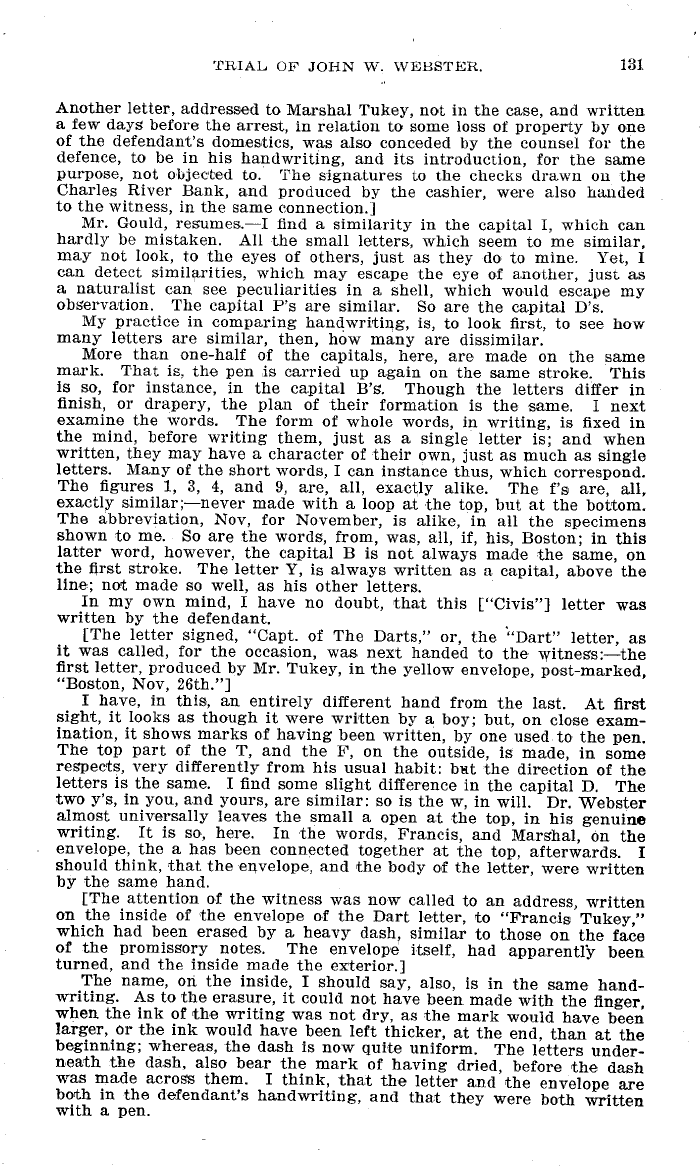|
TRIAL OF JOHN W. WEBSTER. 131.
Another letter, addressed to Marshal Tukey, not in the case, and written
a few days before the arrest, in relation to some loss of property by one
of the defendant's domestics, was also conceded by the counsel for the
defence, to be in his handwriting, and its introduction, for the same
purpose, not objected to. The signatures to the checks drawn on the
Charles River Bank, and produced by the cashier, were also handed
to the witness, in the same connection.]
Mr. Gould, resumes.-I find a similarity in the capital 1, which can
hardly be mistaken. All the small letters, which seem to me similar,
may not look, to the eyes of others, just as they do to mine. Yet, I
can detect similarities, which may escape the eye of another, just as
a naturalist can see peculiarities in a shell, which would escape my
observation. The capital P's are similar. So are the capital D's.
My practice in comparing handwriting, is, to look first, to see how
many letters are similar, then, how many are dissimilar.
More than one-half of the capitals, here, are made on the same
mark. That is, the pen is carried up again on the same stroke. This
is so, for instance, in the capital B's. Though the letters differ in
finish, or drapery, the plan of their formation is the same. I next
examine the words. The form of whole words, in writing, is fixed in
the mind, before writing them, just as a single letter is; and when
written, they may have a character of their own, just as much as single
letters. Many of the short words, I can instance thus, which correspond.
The figures 1, 3, 4, and 9, are, all, exactly alike. The f's are, all,
exactly similar; never made with a loop at the top, but at the bottom.
The abbreviation, Nov, for November, is alike, in all the specimens
shown to me. So are the words, from, was, all, if, his, Boston; in this
latter word, however, the capital B is not always made the same, on
the first stroke. The letter Y, is always written as a capital, above the
line; not made so well, as his other letters.
In my own mind, I have no doubt, that this ["Civis"] letter was
written by the defendant.
[The letter signed, "Capt. of The Darts," or, the "Dart" letter, as
it was called, for the occasion, was next handed to the witness: the
first letter, produced by Mr. Tukey, in the yellow envelope, post-marked,
"Boston, Nov, 26th."]
I have, in this, an entirely different hand from the last. At first
sight, it looks as though it were written by a boy; but, on close exam-
ination, it shows marks of having been written, by one used to the pen.
The top part of the T, and the F, on the outside, is made, in some
respects, very differently from his usual habit: bat the direction of the
letters is the same. I find some slight difference in the capital D. The
two y's, in you, and yours, are similar: so is the w, in will. Dr. Webster
almost universally leaves the small a open at the top, in his genuine
writing. It is so, here. In the words, Francis, and Marshal, on the
envelope the a has been connected together at the top, afterwards. I
should think, that the envelope, and the body of the letter, were written
by the same hand.
[The attention of the witness was now called to an address, written
on the inside of the envelope of the Dart letter, to "Francis Tukey,"
which had been erased by a heavy dash, similar to those on the face
of the promissory notes. The envelope itself, had apparently been
turned, and the inside made the exterior.]
The name, on the inside, I should say, also, is in the same hand-
writing. As to the erasure, it could not have been made with the finger,
when the ink of the writing was not dry, as the mark would have been
larger, or the ink would have been left thicker, at the end, than at the
beginning; whereas, the dash is now quite uniform. The letters under-
neath the dash, also bear the mark of having dried, before the dash
was made across them. I think that the letter and the envelope are
both in the defendant's handwriting, and that they were both written
with a pen.
|

